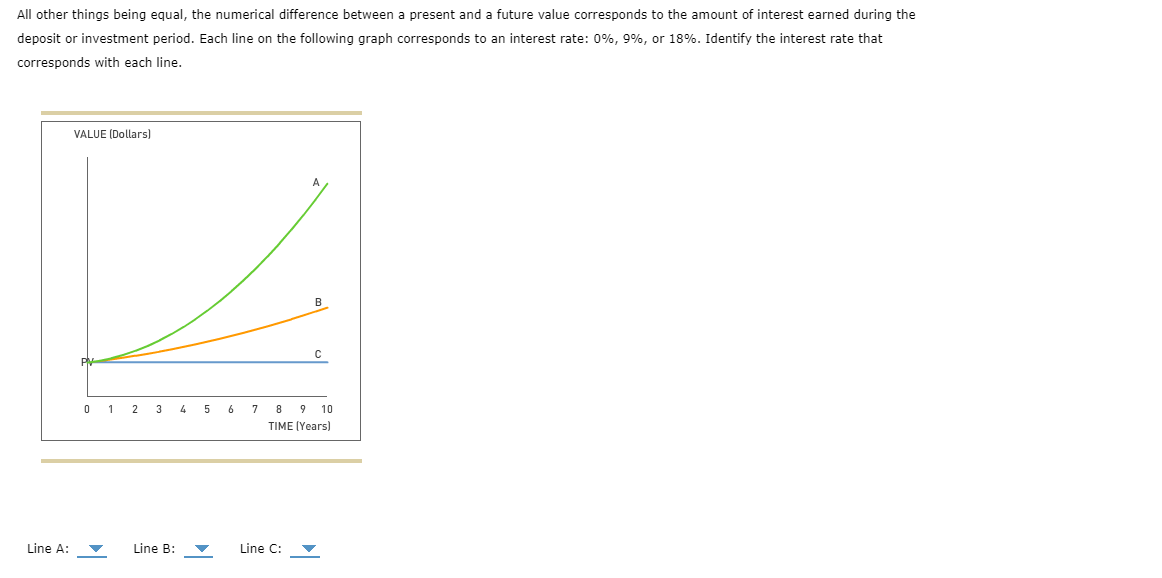The principal of the time value of money is probably the single most important concept in financial management. One of the most frequently encountered applications involves the calculation of a future value. The process for converting present values into future values is called four time-value-of-money variables. Which of the following is not one of these variables? The present value (PV) of the amount invested The duration of the investment (N) The interest rate (I) that could be earned by invested funds The inflation rate indicating the change in average prices . This process requires knowledge of the values of three of
The principal of the time value of money is probably the single most important concept in financial management. One of the most frequently encountered applications involves the calculation of a future value. The process for converting present values into future values is called four time-value-of-money variables. Which of the following is not one of these variables? The present value (PV) of the amount invested The duration of the investment (N) The interest rate (I) that could be earned by invested funds The inflation rate indicating the change in average prices . This process requires knowledge of the values of three of
Chapter11: Capital Budgeting Decisions
Section: Chapter Questions
Problem 14MC: This calculation determines profitability or growth potential of an investment, expressed as a...
Related questions
Question

Transcribed Image Text:3. Future value
The principal of the time value of money is probably the single most important concept in financial management. One of the most frequently
encountered applications involves the calculation of a future value.
The process for converting present values into future values is called
four time-value-of-money variables. Which of the following is not one of these variables?
O The present value (PV) of the amount invested
O The duration of the investment (N)
O The interest rate (I) that could be earned by invested funds
O The inflation rate indicating the change in average prices
This process requires knowledge of the values of three of

Transcribed Image Text:All other things being equal, the numerical difference between a present and a future value corresponds to the amount of interest earned during the
deposit or investment period. Each line on the following graph corresponds to an interest rate: 0%, 9%, or 18%. Identify the interest rate that
corresponds with each line.
Line A:
VALUE (Dollars)
0 1 2 3
Line B:
4 5
6
7
B
8
9 10
TIME (Years)
Line C:
Expert Solution
This question has been solved!
Explore an expertly crafted, step-by-step solution for a thorough understanding of key concepts.
This is a popular solution!
Trending now
This is a popular solution!
Step by step
Solved in 2 steps

Knowledge Booster
Learn more about
Need a deep-dive on the concept behind this application? Look no further. Learn more about this topic, finance and related others by exploring similar questions and additional content below.Recommended textbooks for you

Principles of Accounting Volume 2
Accounting
ISBN:
9781947172609
Author:
OpenStax
Publisher:
OpenStax College

Survey of Accounting (Accounting I)
Accounting
ISBN:
9781305961883
Author:
Carl Warren
Publisher:
Cengage Learning

Pfin (with Mindtap, 1 Term Printed Access Card) (…
Finance
ISBN:
9780357033609
Author:
Randall Billingsley, Lawrence J. Gitman, Michael D. Joehnk
Publisher:
Cengage Learning

Principles of Accounting Volume 2
Accounting
ISBN:
9781947172609
Author:
OpenStax
Publisher:
OpenStax College

Survey of Accounting (Accounting I)
Accounting
ISBN:
9781305961883
Author:
Carl Warren
Publisher:
Cengage Learning

Pfin (with Mindtap, 1 Term Printed Access Card) (…
Finance
ISBN:
9780357033609
Author:
Randall Billingsley, Lawrence J. Gitman, Michael D. Joehnk
Publisher:
Cengage Learning